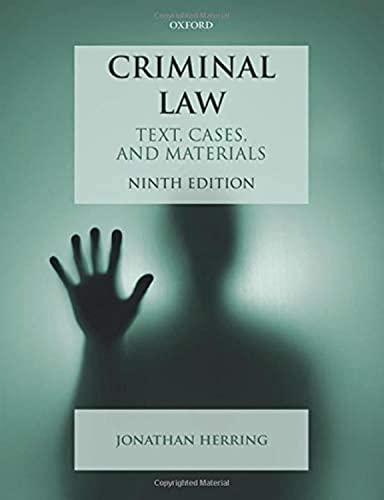Question
Fact Pattern: Last week, we examined the issue of abortion insofar as it implicates a woman's right to personal autonomy. That has been the primary
Fact Pattern:
Last week, we examined the issue of abortion insofar as it implicates a woman's right to personal autonomy. That has been the primary focus of United States Supreme Court opinions addressing the issue.
Restrictions on the ability to obtain an abortion, quite obviously, affect women in ways that they will never affect men. For this reason, such restrictions arguably implicate not just substantive due process concerns, but also equal protection concerns.
For this week's discussion, imagine that a state has implemented a law that clearly burdens a woman's ability to obtain an abortion. Also, imagine that you represent that woman in a suit against the state challenging that law.
Instructions:
Do you agree with the following? Conclude "yes" or "no" and explain why. In your explanation, be sure to provide the rule and apply the law to the facts:
In 2019, Ohio's "heartbeat law", the Human Rights and Heartbeat Protection Act, which essentially bans abortion in Ohio after any embryonic cardiac activity is detected, was signed into law. Shortly thereafter, a County Common Please Judge, Christian Jenkins, issued a restraining order against the law citing the ""ban on abortion procedures after a fetal heartbeat could be detected clearly discriminates against pregnant women and places an enormous burden on them to secure safe and effective health care such that it violates Ohio's Equal Protection and Benefit Clause and is therefore unconstitutional.""
Ohio has been on the battlefront between abortion rights and right to life and prohibitive legislation has repeatedly been subject to judicial review and in Akron Ohio v. Akron Center for Reproductive Health, the Supreme Court found unconstitutional a law requiring second-trimester abortions be performed in hospitals, requirements that practitioners advise patients of the status of the pregnancy, stage of fetal development, expected date of viability, health risks of abortion, and the availability of adoption agencies and childbirth resources. The Supreme Court also declared unconstitutional provisions in the ordinance requiring women to wait 24 hours after seeking an abortion, requiring parental consent for minors seeking abortions, and requiring that aborted fetuses be disposed of in a "humane" and "sanitary" manner.
Link -> https://supreme.justia.com/cases/federal/us/462/416/
The Supreme Court issued opinions providing greater protection for personal liberty beginning with Griswold v. Connecticut (1965) where the court struck down laws restricting contraceptives. Applying "strict scrutiny", the Court held that law(s) violate "due process" when they infringe on the "right to privacy in sacred precincts." Since Roe v. Wade, the right of privacy was held to protect a woman's liberty to choose an abortion and the right to privacy was being transformed into a right of personal autonomy and includes Obergefell v. Hodges, the fundamental right to marry whomever you want. Finally, in Planned Parenthood v. Casey, the court ruled individuals have fundamental privacy rights and any restrictions of fundamental or privacy rights must not create an "undue burden" for the individual.
The Ohio "heartbeat law" is currently in flux and Ohio voters this November will decide if abortion rights will be codified into the State of Ohio Constitution. Issue #1 upends the "heartbeat law" and would permanently remove virtually all limits on abortion, legalize abortion on demand at *any* stage of pregnancy and give Planned Parenthood the power to make life and death decisions.
Step by Step Solution
There are 3 Steps involved in it
Step: 1

Get Instant Access to Expert-Tailored Solutions
See step-by-step solutions with expert insights and AI powered tools for academic success
Step: 2

Step: 3

Ace Your Homework with AI
Get the answers you need in no time with our AI-driven, step-by-step assistance
Get Started


